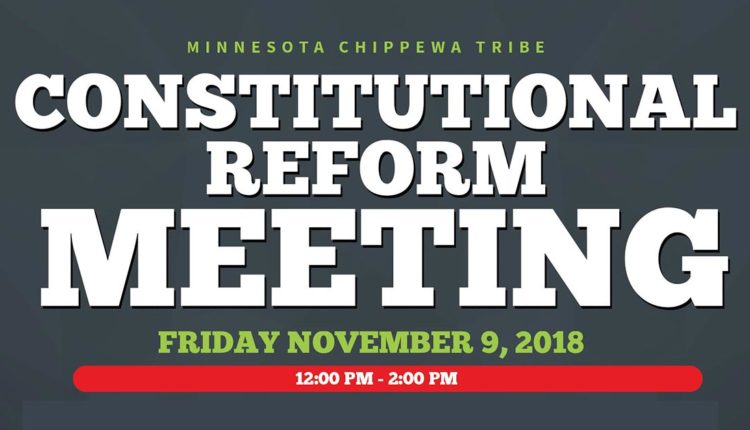The Leech Lake Band of Ojibwe Government Relations Office is announcing a public meeting for LLBO Band Members regarding the current status of constitutional reform efforts at the MN Chippewa Tribe.
The informational meeting will be held on November 9, 2018 from 12:00 PM until 2:00 PM at Leech Lake Tribal College in the LeAnn Dick Lecture Hall (Oak Hall).
Interested Band Members will get an update on the latest developments regarding the Constitutional Convention being planned by the MN Chippewa Tribe. Information regarding the delegate selection process will also be presented. Anyone interested in being a delegate is highly encouraged to attend this meeting. If you are unable to attend please use the contact info below to express your interest.
For more information, please contact Lenny Fineday, Government Relations Specialist, at 218-335-8246
Learn more about the MCT Constitution:
MN Chippewa Tribe Constitutional Convention Info
1938 MCT Corporate Charter
48 Stat. 984 — The Indian Reorganization Act
1936 MCT Constitution
1963 Revised Constitution and Bylaws
MN Chippewa Tribe Government Student Handbook
Chapter 1 — Traditional Chippewa Tribal Government
Chapter 2 — Chippewa Treaties
Chapter 3 — The Indian Reorganization Act
Chapter 4 — Minnesota Chippewa Tribe Structure and Powers
Chapter 5 — Federal Legislation and Policy
Chapter 6 — Minnesota Chippewa Tribe Programs and Services[/bg_collapse]
Constitutional Information
This information is posted on MCT Website at this link.
An important aspect of any Constitution is to outline the rule of law for the nation and creating a system of governmental powers that outlines the rights of members and responsibilities of elected officials. The articles are like chapter headings, describing the purpose of each portion, each article is then separated into sections, like paragraphs. One Article grants each RBC the authority to make decisions on their own reservation.
Many constitutions have a three branch government that check and balance each other, typically a legislative branch that makes laws, an executive branch that executes the laws and a judicial branch that interprets the laws. Our MCT Constitution does not have a three branch system instead our elected officials serve as lawmakers, executors, and ultimate decision makers; in fact in 1980 the TEC issued an official interpretation that they (the TEC) were the only ones who could interpret the MCT Constitution. Constitutions also outline who their citizens are and the boundaries of their jurisdiction. Over time our MCT Constitution has changed.
The original MCT Constitution was adopted on June 18, 1934 and approved by the Secretary of the Interior on July 24, 1936, pursuant to the authority granted in the 1934 Indian Reorganization Act. A Corporate Charter accompanied the MCT Constitution, ratified on November 13, 1937; it was ultimately revoked by an act of Congress on February 12, 1996. This Constitution has up to two delegates from each community within each reservation; there were about 65 elected officials. The delegates then selected two people from each reservation to serve as the Tribal Executive Committee (TEC). TEC members then selected who was going to be the President, Vice President, Secretary and Treasurer.
Citizenship within the MCT was debated for a long time, our leaders at that time wanted all descendants included in membership, but were forced to agree to use the 1/4 degree blood quantum that we still have in effect today.
Our Constitution, this has changed a little overtime with referendums approved by voters and the Secretary of the Interior. The first change happened by a referendum of voters in 1963, the Assistant Secretary of the Interior approved the Revised Constitution on March 3, 1964. This change created the “Revised” Constitution, removed the local charters, created the Reservation Business Committee structure, implemented 1/4 degree blood quantum, and changed term limits from 1 year to 4 years.
More changes were approved by voters and the Secretary of the Interior in 1972. Footnotes on the MCT Constitution, 1972 version, highlight changes:
1. Voting age was changed to 18,
2. Candidates for office must be at least 21 years of age as well as enrolled in and reside on the reservation of their enrollment.
Before the 1972 constitutional amendment, the MCT acted more like one. People were eligible for services on any of the six reservations and could even run for office on any reservation as long as they were enrolled in the MCT.
More changes to the MCT Constitution were approved by voters and the Secretary of the Interior in 2005/2006. Almost 83% of the members who voted on November 22, 2005 approved two measures:
1) Proposed Amendment A:
A candidates for Chairman, Secretary-Treasurer and Committeeman must be an enrolled member of the Tribe and reside on the reservation of his or her enrollment for one year before the date of election. No member of the Tribe shall be eligible to hold office either as a Committeeman or Officer, until he or she has reached his or her twenty first (21) birthday on or before the date of election (4,127 to 846) and;
2) Proposed Amendment B:
No member of the Tribe shall be eligible to hold office either as a Committeeman or Officer, if her or she has ever been convicted of a felony of any kind; or a lesser crime involving theft, misappropriation, or embezzlement of money, funds, assets, or property of an Indian tribe or a tribal organization.
The current MCT Constitution can be changed by a vote of the people, 20% of the resident voters or 8 members of the TEC can ask the Secretary of the Interior to call for a referendum where all MCT members are then allowed to vote on a proposed change. The Constitution requires 30% of those entitled to vote must vote and if a majority of the voters agree, the change is implemented.

